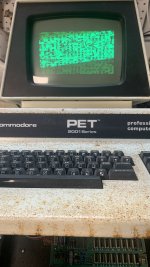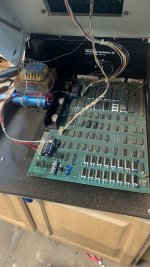I'm not sure what the "scientific addition" is.
I'm only relatively recently familiar with these boards and I have successfully repaired two of them. There are a number of ways you could start the fault finding process.
Firstly it pays to have the Dynamic Pet schematics at hand, these are on Zimmers. I had them printed out to a paper folder with large fold out schematics to assist servicing.
The usual initial checks involve things like checking all the power supplies.
It is good that you have a display, even garbled, as at least a lot of the VDU's drive circuitry is working as is the VDU. And your 4116 DRAM and 2114 SRAM's are in sockets, this is very helpful.
One of the first things to check is that the 555 timer is sending out a proper reset signal. For example the screen you have is often seen momentarily after switch on before the boot to BASIC process takes place after a reset.
There are a number of CPU & address checks you can do involving a NOP generator that you will read about on the forum and various Romulan-Ramulating tools and Pettester ROMs to help diagnose trouble. Which others will show you how to use.
My approach was to confirm that the ROM's & RAM were all normal. To do this I created new ROM's from the TMS2532JL (and one 2716) and programming with the GQ-4x programmer. Also I had known good 4116's and 2114's IC's to fit. This allowed me to find the faulty ROM & RAM IC's via substituting the originals back in one at a time. After that I was able to focus on the remaining parts such as the PIA's and VIA and the TTL logic IC's. For testing, you only need to fit the ROW I DRAMS (it will boot with 16k of memory), this can help if some of the IC's in row J are defective and are corrupting the function of the Row I ram. It pays to stock up on spare RAM & ROM IC's, they come in very handy. Also the GQ-4x programmer is handy for reading the ROM's and comparing that to the Zimmers binary files. In one of my boards 3 of the ROMs were badly file damaged.
In general, if the DRAM Is defective in the lower 16k (or inhibited by faulty IC's in the upper 16k) you will have a black screen. If the CPU is not executing code (or proper code in ROM) then it won't boot to BASIC and you will have a garbled screen.
Ideally the tools you would have should include a meter & scope and at least a logic probe to start with, if no scope.


